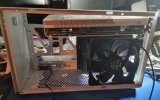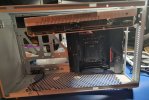This is more of a work log than anything, but I'm preparing a case modification of the Shiny Snake S400 (in white), a 10.8L ITX case mostly meant for air cooling. In theory, one would be able to install a 120 mm AIO / radiator as well, but only with a very short GPU. I'd call it the cheaper version of the Fractal Terra, with much better airflow, but less sophisticated construction and overall quality.
Case measurements / structural description for reference:
Dimensions: 155 x 205 x 340 mm (W x H x L)
The main case frame consists of three parts, a bottom half, a back half, which is attached at the bottom to the bottom frame, and the combined top and front panel. The mainboard / GPU compartment divider, referred to as the mainboard tray, sits in the middle and is attached to both the bottom and the back of the case frame. All of this is done with creative metal bending or cut-outs, and hold together with (M2) screws, so there are no cheap rivets or other nasties that may spoil the fun.
The depth available from mainboard frame to the top varies between 20 to up 31 mm. There is a top bar attached to the frame, which both supplies the mounting holes and screws for the handle on top.The front panel sits on said top bar for better stabilization of both the handle attachment and the overall structure. There are two small holes cut into the mesh top for the screws of the handle, which attach from inside the case, through the top bar.
My original goal was to figure out if I could use a very thin GPU, ie. at max, around 45ish mm of depth, eg. the PNY RTX 4070 Verto Dual, that I'd deshroud and then combine within the same space with a regular to thin-sized AIO radiator.
This would have either been achieved by using smaller fans for the GPU, a custom or improved new shroud, and the GPU hiding partially behind the radiator, or if the GPU is, in its width and height, small enough to fit on top of the 120 mm radiator, that'd been a thing as well.
TL;DR: THAT didnt work out - the advertised GPU space within the S400 is only half true. Ie. for a GPU, it works, because it doesnt need to use the whole height, but as soon as you need to use more than what "was meant to be", it gets really nasty.
Version #1:
So after being discouraged by all of this, I put the case away for a few days, to suddenly get the idea of: Wait, above the mainboard tray, there is actually quite a bit of space - THAT could work out for install a radiator and maybe even thin fans?
Alas, its certainly enough space - to install a radatior, that is. OR full-sized fans. But not both.
So the aim of this mod is to cut open the top within the required area of where the future AIO radiator is going to reside, with enough metal left to a) not make the top frame completely wobbly, and b) to still be able to mount the radiator beneath or on top of it.
Another option would be to just cut circular areas into the top, for the air flow of the fans.
There is also the VERY solid fan holder of the case left, which would be re-attached to provide more stability to the top frame.
A later addition might be to create a topper, either 3d printed or just a simple metal frame, in a similar cream-white color, and then attach it to the rest of the case.
Version #2:
When I was contemplating about exchanging the RTX 3050 with a 4060, I thought: Maybe, just maybe, a side-by-side solution WITHOUT cutting up the top of the case could work? And currently, looks very much likely: With a low profile GPU like the Gigabyte 4060 LP, which is just 69 mm wide, it should be possible to add a 240 mm radiator on top. Depending on how its set up, one might have to cut away a bit at the end of the case, ie. the PCI slots, but aside of that, initial test measures show it might work out
So in version #2, one would need a LP GPU, then a 240 mm AIO would fit on top, with about 5 - 10 mm of space (depending on the radiator width, most 120 wide ones are actualy slightly wider than 120 mm).
cu, w0lf.
Case measurements / structural description for reference:
Dimensions: 155 x 205 x 340 mm (W x H x L)
The main case frame consists of three parts, a bottom half, a back half, which is attached at the bottom to the bottom frame, and the combined top and front panel. The mainboard / GPU compartment divider, referred to as the mainboard tray, sits in the middle and is attached to both the bottom and the back of the case frame. All of this is done with creative metal bending or cut-outs, and hold together with (M2) screws, so there are no cheap rivets or other nasties that may spoil the fun.
The depth available from mainboard frame to the top varies between 20 to up 31 mm. There is a top bar attached to the frame, which both supplies the mounting holes and screws for the handle on top.The front panel sits on said top bar for better stabilization of both the handle attachment and the overall structure. There are two small holes cut into the mesh top for the screws of the handle, which attach from inside the case, through the top bar.
My original goal was to figure out if I could use a very thin GPU, ie. at max, around 45ish mm of depth, eg. the PNY RTX 4070 Verto Dual, that I'd deshroud and then combine within the same space with a regular to thin-sized AIO radiator.
This would have either been achieved by using smaller fans for the GPU, a custom or improved new shroud, and the GPU hiding partially behind the radiator, or if the GPU is, in its width and height, small enough to fit on top of the 120 mm radiator, that'd been a thing as well.
TL;DR: THAT didnt work out - the advertised GPU space within the S400 is only half true. Ie. for a GPU, it works, because it doesnt need to use the whole height, but as soon as you need to use more than what "was meant to be", it gets really nasty.
This means in detail, that for the side panels to be slotted into place, they require a leading rail, which is made from parts of the excess metal sheet of the case. This takes away about 5 - 10 mm per side, so you only get 55 - 60ish mm of actual usable space in the GPU compartment.
Also, the brushed-aluminum looking bottom side panel, which houses the small front io shield, ie. power button + USB / USB-C, blocks at least 10 mm of space to the bottom.
This works well with a 3 slot GPU, so up to 65 mm in depth is totally doable, but not so well if you actually need to use the height of the case to the max. You'd then either have to raise the whole top, and thus create some sort of slot-in spacer panels, or add more space to the side, which requires replacing the side panels or at least modifying them heavily, plus adding additional case material (read: metal sheet) to achieve this. At this point, it'd probably better to just custom build your own case, or to save effort and your nerves, to get a bigger case, eg. the Sharkoon QB One or the Dan Case A4-H2O.
Also, the brushed-aluminum looking bottom side panel, which houses the small front io shield, ie. power button + USB / USB-C, blocks at least 10 mm of space to the bottom.
This works well with a 3 slot GPU, so up to 65 mm in depth is totally doable, but not so well if you actually need to use the height of the case to the max. You'd then either have to raise the whole top, and thus create some sort of slot-in spacer panels, or add more space to the side, which requires replacing the side panels or at least modifying them heavily, plus adding additional case material (read: metal sheet) to achieve this. At this point, it'd probably better to just custom build your own case, or to save effort and your nerves, to get a bigger case, eg. the Sharkoon QB One or the Dan Case A4-H2O.
Version #1:
So after being discouraged by all of this, I put the case away for a few days, to suddenly get the idea of: Wait, above the mainboard tray, there is actually quite a bit of space - THAT could work out for install a radiator and maybe even thin fans?
Alas, its certainly enough space - to install a radatior, that is. OR full-sized fans. But not both.
So the aim of this mod is to cut open the top within the required area of where the future AIO radiator is going to reside, with enough metal left to a) not make the top frame completely wobbly, and b) to still be able to mount the radiator beneath or on top of it.
Another option would be to just cut circular areas into the top, for the air flow of the fans.
There is also the VERY solid fan holder of the case left, which would be re-attached to provide more stability to the top frame.
A later addition might be to create a topper, either 3d printed or just a simple metal frame, in a similar cream-white color, and then attach it to the rest of the case.
Version #2:
When I was contemplating about exchanging the RTX 3050 with a 4060, I thought: Maybe, just maybe, a side-by-side solution WITHOUT cutting up the top of the case could work? And currently, looks very much likely: With a low profile GPU like the Gigabyte 4060 LP, which is just 69 mm wide, it should be possible to add a 240 mm radiator on top. Depending on how its set up, one might have to cut away a bit at the end of the case, ie. the PCI slots, but aside of that, initial test measures show it might work out
So in version #2, one would need a LP GPU, then a 240 mm AIO would fit on top, with about 5 - 10 mm of space (depending on the radiator width, most 120 wide ones are actualy slightly wider than 120 mm).
cu, w0lf.
Last edited:


